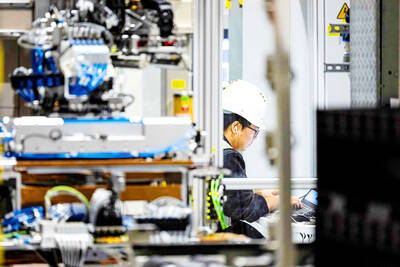Yageo Corp (國巨), the world’s third-largest supplier of ceramic capacitors, yesterday reported a double-digit decline in revenue for last month, as the COVID-19 outbreak stalled the full resumption of operations at its plants in China.
Consolidated revenue tumbled 13.5 percent year-on-year to NT$2.68 billion (US$88.95 million), from NT$3.3 billion, the lowest level in about two-and-a-half years. On a monthly basis, revenue slumped 18.7 percent.
Revenue in the first two months of this year totaled NT$5.99 billion, down from NT$7.88 billion in the same period last year, the company said.
“Demand remained strong in February, but the company’s capacity in China was restricted by the epidemic, which slowed the resumption of production,” Yageo said.
The company had hoped to boost its factory utilization rate to 60 to 65 percent by the end of this month.
However, as transportation restrictions remain in place in China, it now aims to lift the rate to 50 percent at the end of the month, from between 35 and 38 percent last month, it said.
“Shipments declined more than 50 percent last month from the previous month as the company saw its inventory turnover of finished goods fall to below 30 days,” Yageo said.
The company also blamed severe delays in transportation and customs declaration for the revenue decline.
Supply constraints worsened after the Lunar New Year holiday, as employees did not return to work as planned due to the lockdowns caused by the outbreak, the company said, adding that its recruitment plans were also affected.
To solve the capacity bottleneck, Yageo plans to fully utilize its factory in Kaohsiung.
To do so, the company plans to hire 1,500 workers and 100 engineers to boost production in Taiwan, it said.
Looking ahead, supply would continue to be constrained in the short term, the company said, but added that it is optimistic about revenue outlook in the long term.
Walsin Technology Corp (華新科技), a passive components maker, reported that revenue last month fell 13.4 percent year-on-year and 5.2 percent month-on-month to NT$1.91 billion, as the outbreak led to labor shortages and reduced working days.
In the first two months of this year, revenue dipped 28.71 percent annually to NT$3.93 billion, from NT$5.51 billion, it said in a statement.

CHIP RACE: Three years of overbroad export controls drove foreign competitors to pursue their own AI chips, and ‘cost US taxpayers billions of dollars,’ Nvidia said China has figured out the US strategy for allowing it to buy Nvidia Corp’s H200s and is rejecting the artificial intelligence (AI) chip in favor of domestically developed semiconductors, White House AI adviser David Sacks said, citing news reports. US President Donald Trump on Monday said that he would allow shipments of Nvidia’s H200 chips to China, part of an administration effort backed by Sacks to challenge Chinese tech champions such as Huawei Technologies Co (華為) by bringing US competition to their home market. On Friday, Sacks signaled that he was uncertain about whether that approach would work. “They’re rejecting our chips,” Sacks

NATIONAL SECURITY: Intel’s testing of ACM tools despite US government control ‘highlights egregious gaps in US technology protection policies,’ a former official said Chipmaker Intel Corp has tested chipmaking tools this year from a toolmaker with deep roots in China and two overseas units that were targeted by US sanctions, according to two sources with direct knowledge of the matter. Intel, which fended off calls for its CEO’s resignation from US President Donald Trump in August over his alleged ties to China, got the tools from ACM Research Inc, a Fremont, California-based producer of chipmaking equipment. Two of ACM’s units, based in Shanghai and South Korea, were among a number of firms barred last year from receiving US technology over claims they have

It is challenging to build infrastructure in much of Europe. Constrained budgets and polarized politics tend to undermine long-term projects, forcing officials to react to emergencies rather than plan for the future. Not in Austria. Today, the country is to officially open its Koralmbahn tunnel, the 5.9 billion euro (US$6.9 billion) centerpiece of a groundbreaking new railway that will eventually run from Poland’s Baltic coast to the Adriatic Sea, transforming travel within Austria and positioning the Alpine nation at the forefront of logistics in Europe. “It is Austria’s biggest socio-economic experiment in over a century,” said Eric Kirschner, an economist at Graz-based Joanneum

France is developing domestic production of electric vehicle (EV) batteries with an eye on industrial independence, but Asian experts are proving key in launching operations. In the Verkor factory outside the northern city of Dunkirk, which was inaugurated on Thursday, foreign specialists, notably from South Korea and Malaysia, are training the local staff. Verkor is the third battery gigafactory to open in northern France in a region that has become known as “Battery Valley.” At the Automotive Energy Supply Corp (AESC) factory near the city of Douai, where production has been under way for several months, Chinese engineers and technicians supervise French recruits. “They